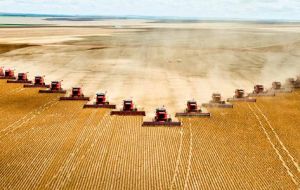MercoPress. South Atlantic News Agency
Mercosur consolidates as leading soybean region with 52% of world’s production
 By 2020 the region should be producing an additional 50 million tons
By 2020 the region should be producing an additional 50 million tons In twelve years Mercosur has consolidated as the leading region in soybean production with 52% of the world crop and the potential to further expand area and yields.
Argentina, Brazil, Paraguay, Uruguay and Bolivia harvest 136 million tons annually, compared to the 83 from the United States and the world’s 260 million tons. Further more: in 1999 Mercosur had 26 million hectares planted with soybeans (and 56 million tons), but by 2011 the area has grown to over 49 million hectares.
The figures were revealed this week at the Mercosoja 2011 forum in Rosario, Argentina, which brings together farmers, millers, scientists and technicians from all over the world, and is organized by Argentina’s Soybeans Chain, Acsoja.
“The US has no more farmland to expand production while Latin America can increase its harvest by another 50 million tons by 2020”, said Fabio Trigheirinho from the Brazilian Association of Vegetable Oils Industry, Abiove, adding that by 2020 the world will be demanding 319 million tons of soybeans.
This represents an additional 59 million tons from current production with an annual growth estimated at 2.1%. Some estimates put 2020 demand at an even higher level.
“Since the US agriculture frontier is virtually consolidated, it will be the task of Brazil and Argentina to face the challenge and fill the gap”, said Trigueirinho.
On the demand side, China and India plus more sophisticated diets in developed countries and other uses such as bio-diesel, ensure a sustained market, according to Rodolfo Rossi, Mercosoja 2011 president, who pointed out that in the last two years world imports of soybeans have ballooned 77.2% to 80.7 million tons.
The oilseed is not only traded as beans but also as oil and flour, which represents greater added value particularly for Argentina that only sells 18% as beans (compared to 42% for Brazil) and the rest industrialized. Argentina is the world’s leading exporter of soy oil.
Trigueirinho estimates Brazil will be harvesting 94 million tons of soybeans by 2020. The last crop totalled 75 million tons, only second to the US.
“The development of soybeans in Brazil has been spectacular, almost fantastic” said Americo Dall’ Agnol from Brazil’s Agriculture Research and Technology Office, Embrapa. In the last forty years land planted with soybeans jumped 1762% from 1.3 million to 24 million hectares, while production increase was even more impressive, from 1.5 million to 75 million tons, equivalent to 4907%.
Trigueirinho said Argentina by 2020 should have an annual crop of 75 million tons, which is 20 million tons more than the 50 million tons of the last crop, which suffered enormously because o fan ongoing drought.
As in Brazil, Argentina had a rather unstable relation with soybeans until twelve years ago, growing 119% to reach 18.5 million hectares planted with the marvellous oil seed.
In Mercosur junior members the evolution of soybeans has likewise been mind boggling. In Paraguay in two decades the area planted reached 540.000 hectares and production jumped from a million tons to eight million tons currently.
“Soy represents over 50% of Paraguay’s agriculture production and almost 40% of total exports” according to Luis Enrique Cubilla, one of Paraguay’s leading experts in the oilseed.
In Bolivia production is 1.8 million tons from 1.2 million hectares of land. Soybeans are third behind hydrocarbons and minerals in the country’s exports.
Finally in Uruguay from 200.000 tons in 2003, production now is 1.8 million tons. Over 60% of soy farming in Uruguay is done by Argentine farmers and corporations who arrived in the country disenchanted with some of President Cristina Fernandez de Kirchner policies for the camp.




Top Comments
Disclaimer & comment rules-

-

-

Read all comments88mt out of a world total of 183mt (http://www.nationmaster.com/graph/agr_pro_soy-agriculture-production-soybean)
Sep 17th, 2011 - 04:27 pm 0. . . . falls a bit short of half, and well short of the production claimed by Argentina (this article),
[For some reason, Argentina/Mercopress is claiming Bolivian production is part of Mercosur]
but the four individual nations that form the tight trading bloc of soy suppliers should be congratulated on turning over so much land to this productive weed.
Across the length and breadth of Brasil, low growing dense forests - 'heavy cerrados' - is being ripped out to plant the weed.
And the 'light cerrados' is bulldosed away even more easily.
So much for biodiversity-protection and the balanced maintainance of the Brasilian forest and central South American 'savanna' environment.
Cargill ' s synthetic gene seeds !!
Sep 17th, 2011 - 05:33 pm 0You have any more good ideas geoff?
Sep 18th, 2011 - 04:41 am 0Or the usual put down,to anything Argentinian??
Commenting for this story is now closed.
If you have a Facebook account, become a fan and comment on our Facebook Page!